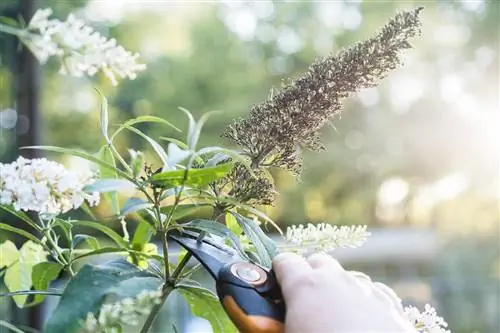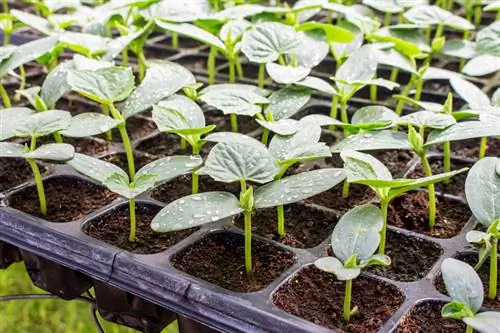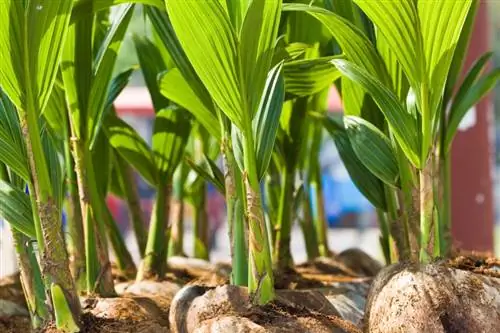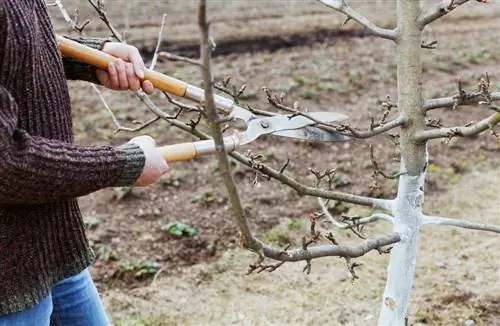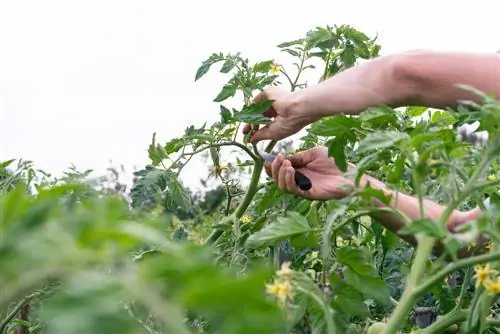- Author admin [email protected].
- Public 2023-12-16 16:46.
- Last modified 2025-01-23 11:22.
In order for the buddleia, also known as butterfly lilac or buddleja, to bloom profusely, regular pruning in spring is necessary. If the butterfly lilac is not cut back, it tends to become bare in the lower area. Severe pruning can encourage the shrub to sprout again.
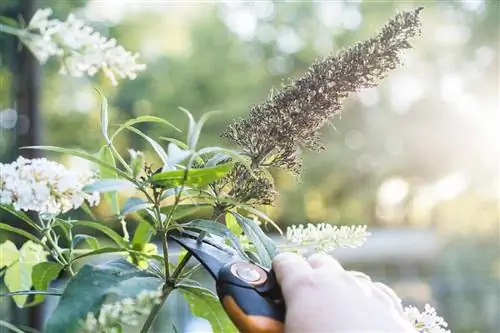
How to cut buddleia?
The buddleia is cut in late winter until the end of February. The shoots are cut back to half to 2/3 of their original size. Diseased and dead wood should be removed. In summer, a care cut can be carried out by cutting back the inflorescences.
Do you have to cut buddleia?
Yes, the annual pruning of the buddleia is a must. This is mainly because the flowers are only formed on annual wood. If the lilac is not cut, fewer and fewer flowers will form. There is also a risk that the lower parts of the branches will age over the years. Regular pruning stimulates branching at the interfaces so that the flowering bush remains compact and dense.
The common lilac differs from the buddleia. When identifying the variety, pay attention to the botanical names to avoid confusion. The buddleia is known under the name “Buddleja davidii”. The common lilac, on the other hand, is called “Syringa vulgaris”. Pruning measures are not common for this species as it already naturally grows evenly. However, smaller cutting measures can be carried out at any time to provide support. This includes, for example, thinning out the lower trunk area. Cutting measures are unproblematic due to the high cutting tolerance.
Excursus
Invasive species
According to the regulation of the Federal Agency for Nature Conservation, the common lilac has been considered extremely invasive since 2013. It is therefore hardly possible for other plant species to grow alongside the aggressive lilac. Cultivation of the species Syringa vulgaris should therefore only be done with caution.
When should buddleia be cut?
The optimal time for the main pruning of butterfly lilac islate winteror the veryearly spring The maintenance pruning should take place in a frost-free, but on the coolest day possible. Low temperatures ensure a low flow of sap, which makes it easier to close the wounds. Ideally, it should be covered so as not to put additional strain on the plant next to the cut.
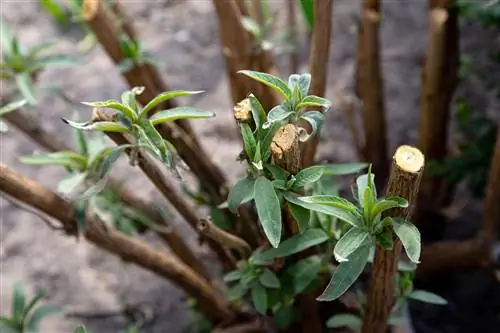
Since pruning leaves large wounds, it should be done in cool temperatures. This stops the flow of sap and makes healing easier.
Maintenance pruning is also possible for young plants over a year old in order to optimally stimulate shoot and flower formation. Cutting back to half to 2/3 of the original size is tolerated without any problems.
In addition, an additional maintenance cut in late summer is recommended. In addition to removing the spent flower candles, individual branches can also be easily cut back if necessary. The main benefit is to prevent seed formation, which can lead to uncontrolled proliferation. If you would like to propagate your shrub in a controlled manner, you can find more information here. In addition, the flowering period can be extended by a few weeks through continuous care, as the remaining energy of the shrub is invested in the flower shoots.
Regular pruning is essential for compact growth combined with lush flowers. Newly planted Buddleja davidii in particular require intensive care in the first few years. In addition to the training cut, the maintenance cut and, if necessary, the rejuvenation cut are essential. All of these measures ensure stable and consistent growth. All of the following statements also apply in the same way to the yellow buddleia.
Average in the first three years
The build-up cut is an essential routine in the first three years of standing. Depending on the growth rate of the variety you choose, the period can be extended to up to five years.
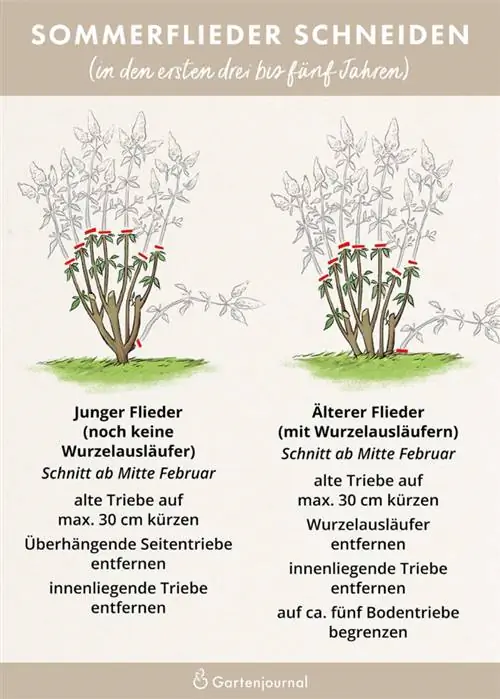
Cutting instructions
- Select a frost-free day in late winter for pruning measures
- Short previous year's shoots above ground to a maximum height of 30 centimeters
- Cut off overhanging side shoots to the ground (ungrafted) or on the trunk (grafted)
- prune thin and weak internal branches
- Limit ungrafted shrubs to a maximum of five ground shoots, cut off excess shoots close to the ground
A number of three to five leading shoots is completely sufficient as a basic structure for ungrafted buddleia.
The formation of ground shoots usually only occurs over the course of the standing period. Therefore, even after the above-mentioned period has expired, pay attention to possible offshoots and shorten them.
Annual care cut in spring
A radical cut leads to equally strong new growth. At least two new shoots will grow out of every pruned branch. Over time, the increasingly dense growth leads to the formation of whorls of branches, which must be thinned out regularly. In order to avoid this extreme sprouting of the butterfly lilac, the pruning measures can be carried out attwo-yearly rhythm.
In the first spring the spent inflorescences of the buddleia are cut off with secateurs (€14.00 at Amazon). Then all shoots that are thinner than a standard pencil or that cross with other shoots are cut off. The chances of success of these shoots are very low due to their stature and competitive growth, but they deprive the plant of important nutrients.
Based on this,the following spring the existing strong branches including inflorescences can be shortened by at least half to two thirds of their length. For thicker specimens, it is recommended to use pruning shears to avoid splintering and tearing the edges of the wound. The ideal intersection point is just above a knocked out or still sleeping eye. At least there should be between two and three eyes per individual shoot.
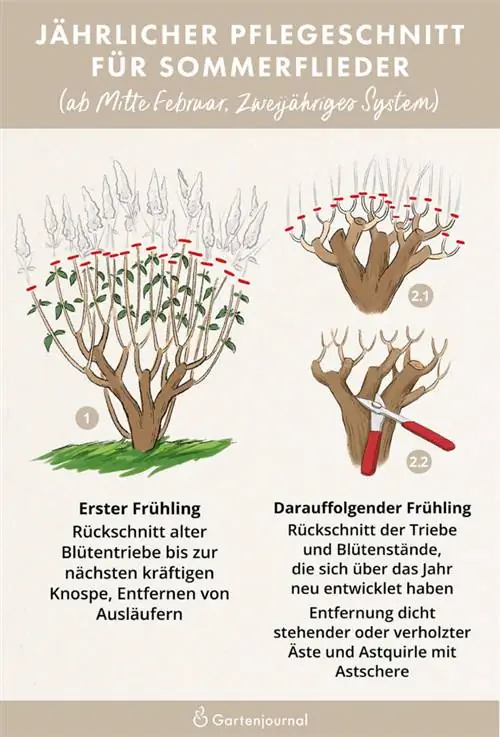
Remove branch whorls and cartilage
Continuous pruning at the same height promotes the formation of new shoots in these places. Even if no budding has occurred at the time of cutting, the measure stimulates the sleeping eyes. As a result, many side branches form in these areas that compete with each other and are therefore weaker. Due to the low level of sunlight, they hardly form new buds and leaves. The formation of these branch whorls is due to the natural growth behavior of Buddleja davidii and can hardly be avoided.
However, this can usually no longer be achieved with individual thinning cuts. It is therefore advisable to make a straight cut below this section. From there the new growth begins.
Cutting woody buddleia
Even woody buddleias that have not been cut for several years can be brought back into shape with a stronger rejuvenation cut. If the shrub still contains some he althy shoots, they should definitely be retained. The cut itself is very strenuous for the plant, so only the branches that no longer sprout should be cut off.
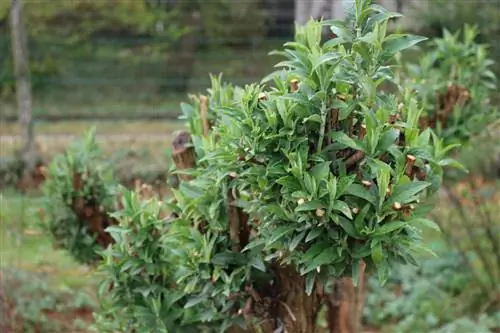
A woody buddleia does not need to be planted if it still has buds.
However, if your butterfly lilac is too woody and no longer forms new buds, it definitely needs to be put on the stick. The entire bush is cut back to a maximum height of 30 centimeters. Due to the severe pruning, the sap collects in the plant. This subsequently stimulates lush new growth.
However, the shrub usually acknowledges this complete rebuilding by not flowering this year. In practice, it has therefore proven useful to distribute radical pruning overseveral years. This reduces the stress caused by each individual cut so that the flower does not have to fail completely. Partial cuts of 30 to 50 centimeters can generally be carried out annually without hesitation.
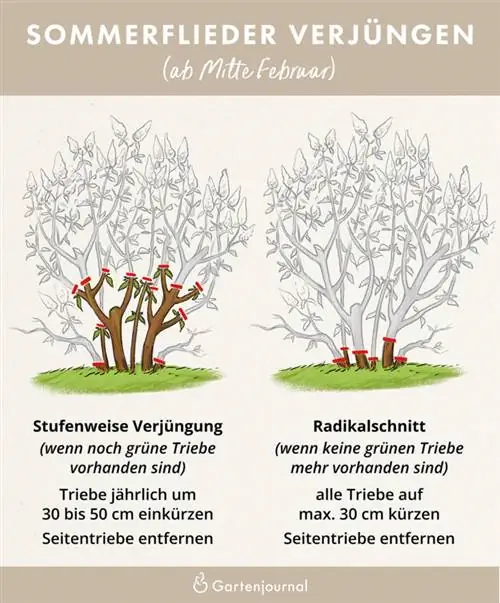
Cutting buddleia in the bucket
You can also cultivate your buddleia in a bucket if it is a suitable variety. Due to their perpetual growth, the common species used for bed planting are not suitable.
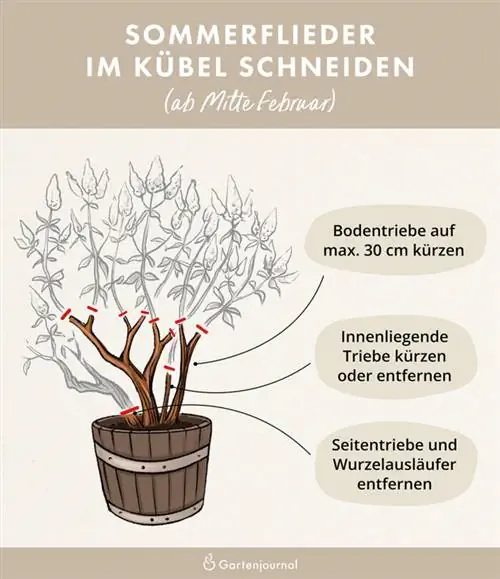
All of the pruning measures described above can be applied to dwarf lilacs and pruning in pots. Extensive maintenance pruning should be carried out every spring to stimulate new growth. In late summer, the panicles that have already bloomed can be broken out. This measure can extend the flowering period by a few weeks. Regular cutting also prevents the shrub from becoming woody. However, if this has already progressed too far, a thorough pruning will also help.
Keep buddleia small
Keeping the buddleia small is not possible due to the natural conditions. The larger the pruning area, the stronger the new growth on the leaf axils and stubs.
In order to be able to regulate growth more closely, we recommend planting a smaller species as an alternative. These reach a maximum height of 1.50 meters and are therefore generally easier to manage in terms of their size and the required space. Use small-growing genera such as “Purple Emperor”, “Buzz Violet” and “Summer Lounge”.
Special feature: Alternate-leaved buddleia
The alternate-leaved buddleia (Buddleja alternifolia) naturally has a different growth habit than Buddleja davidii. While the buddleia forms its flower buds exclusively on one-year-old wood, the alternate-leaved buddleia, also known as waterfall or hanging buddleia, forms its flower buds on two-year-old wood. The buds therefore form in the autumn of the previous year. A large-scale pruning in the spring would therefore destroy them. For this reason, Buddleja alternifoliais only slightly thinned out at bestHowever, only those areas that no longer form flower clusters are rejuvenated. Be careful not to just cut the tips of the shoots. These tend to branch and then only form leaves.
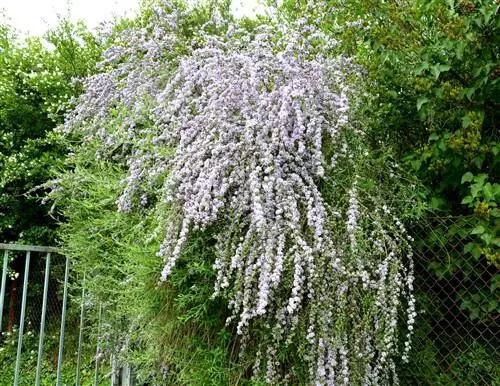
The alternate-flowering buddleia does not require any pruning. However, annual thinning is recommended to maintain uniform, dense growth.

